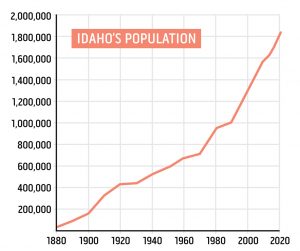To most, the 2020 U.S. Census might just seem like a population count and a showcase of data. And while true, this constitutionally-mandated totaling also carries a heavier weight than just a number.
The Census results shape how $675 billion in federal funding is distributed—money that helps with government programs for transportation, schools, senior and foster care centers, medical assistance programs, and transportation, to name a few. As 2020 nears, Boise and the rest of Idaho are working to ready its residents to be counted, a feat that is no small task.
Why It Matters
In recent years, the Boise area has made headlines as one of the fastest growing cities in the country. According to the United States Census Bureau, Meridian is the fifth fastest growing city with a population of more than 50,000 that has seen a 6.1 percent increase between July 2017 and July 2018. And as the 2020 Census nears, that growth will likely continue to increase.
“The census counts impact the amount of federal dollars received, information on how the community is doing, and political representation across the state and community,” says Hailey Townsend, the communication assistant for COMPASS.

Source: worldpopulationreview.com/states/idaho/
COMPASS, which stands for the Community Planning Association of Southwest Idaho, is an association of local governments working together to plan for the future of the Treasure Valley. For the upcoming census, they have both a communication and a technical role.
“For the 2020 Census, COMPASS is facilitating a broad regional ‘complete count committee’ to coordinate outreach, as well as taking an active role in supporting local outreach efforts and conducting regional outreach to encourage participation in the 2020 Census,” says Townsend. “This role is of increasing importance, as there may be additional reasons for census non-participation, including the format of the Census, potential citizenry questions, political climate, etcetera, than in the recent past.”
COMPASS has also led the technical side of the 2020 Census preparation for Ada and Canyon counties.
“This, while less visible, is also critical to the success and accuracy of the count,” Townsend adds. “This work has included providing residential address lists to the Census Bureau and providing up-to-date city limit information.”
COMPASS has also worked with local cities and counties to request statistical area boundaries for 2020 Census data tabulation and for annual surveys. These data help cities plan and determine eligibility for federal programs.
The Numbers
In 2010, Boise had approximately 81 percent participation of the entire population, which is roughly 5 percent higher than the average county in Idaho. Overall, Idaho had only 77 percent participation, leaving 23 percent uncounted.
According to previous census data, Idaho currently receives $1,400 per person for a total of nearly $3.2 billion each year. Boise receives $33.1 million annually to fund its population of 236,310. Some of Idaho’s highest funded programs are Medicaid, SNAP (commonly known as the food stamp program), Medicare Part B, highway planning and construction, Federal Pell Grants, and the National School Lunch Program.
If the numbers are off due to low participation, funding for that county is drastically affected. And with a growing region, the gap between the actual population and funding received will continue to widen.
For members of the community working to raise awareness, they see room for improvement.
The constant struggle for counties is getting the population to participate. Hard-to-count populations like low-income families, non-English-speaking residents, rural communities, people experiencing homelessness, and others, are sometimes hard to reach.
But over the coming months, local Census employees and community leaders will work to educate all facets of the population on how to be counted. They will mobilize grassroots efforts like hiring local community members to spearhead efforts, make phone calls, hold events, and knock on doors. And for the first time this year, the Census also has a way for people to participate online.
When Is It Happening?
In January, the census will officially begin in remote Alaska and will take place in the rest of the country by April. Apportionment counts will be given to the president in December 2020, and a complete release of data will be given to each state on April 1, 2021. In the coming months, look for information in the mail about participating in the census or visit census.gov and compassidaho.org to help mobilize your community.

